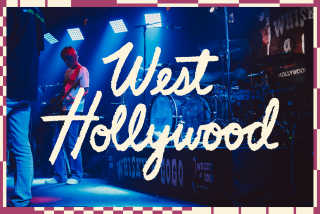L.A.âs boomtown years captured in photos
A few years before he died, photographer C.C. Pierce practically gave away his lifeâs work â a vast collection of remarkable pictures focused on 40 years of explosive growth in Los Angeles, from bucolic outpost to bustling metropolis.
The Huntington Library, then a young institution with little money for acquisitions, was finally able to come throughwith a small sum for Pierce, getting an incredible bargain for an archive that is now priceless.
âAs each year goes by, it seems to take two or three years off my effectiveness in carrying on the business,â he wrote to the Huntington in 1939 in hopes that it would buy his more than 10,000 photos. âI must stop sometime as I am well past 77 and am ready to quit.â
PHOTOS: C.C. Pierceâs L.A. | 1886-1920s
With each click of his camera shutter, Pierce captured a mesmerizing split second of history as Los Angeles changed before his eyes. His work is an unsurpassed visual record of the cityâs commercial blocks and street corner businesses; mansions and rose-covered cottages; parades and fiestas. It remains the Huntingtonâs most heavily used collection.
âHow amazing to be there in the 19th century, to stand on Bunker Hill and see to the San Gabriel Mountains, with the savannas of oaks and no structures or just some very small buildings,â says Jennifer Watts, the curator of photographs at the Huntington Library, Art Collections and Botanical Gardens.
Pierceâs well-organized archive is so comprehensive that it is nearly impossible to pick up a book or magazine article on early Los Angeles without seeing one of his photos.
He arrived from Chicago in 1886 at the age of 25, planning to spend the winter here; instead, he remained until his death in 1946 at the age of 84. Little is known of his life aside from his marriage to Hattie Gower whose family gave Gower Street its name.
Examining even a fraction of Pierceâs output (the Huntington has 51 linear feet of folders in 63 acid-free boxes) is like watching a time-lapse film of the cityâs expansion.
An isolated Pierce photo may be nothing more than a curio of the past, but when studied by the hundreds, the pictures take the viewer on a hypnotic journey through a city of muddy streets lined with pepper trees; of men in derbies and wing collars; of women in elaborate hats and long, high-necked dresses; of bicycles, horse-drawn trolleys and streetcars; and block after block of ornate buildings with gingerbread turrets that gave way to the modern city.
Easily recognized are the old City Hall and the Bradbury Building on Broadway, St. Vibianaâs on Main Street and the imposing courthouse with its clock tower on Temple Street. But it is disorienting to try to add so many vanished landmarks to oneâs mental map of downtown: the Baker Block; the Temple Block and Sonora Town, all wiped away in the name of progress.
A magnifying glass reveals microscopic details, a âWhereâs Waldoâ for historians: A restaurant offering tamales and waffles; signs on buildings advertising Ghirardelliâs Breakfast Cocoa and Tom Howe Bourbon.
People rarely smile in Pierceâs earliest photos, though; his shutter speed was so slow that any motion blurred the image. A man crossing the street or a child waving at the camera leaves nothing but a ghostly trace.
Oddly enough, Pierce left virtually no pictures of himself. But he cared about recording history, to the point that he bought out the inventories of other early photographers.
Pierce keenly felt the passing of time, and in later years was careful to label â using pencil and in spidery handwriting â photos of the bygone era. On the back of a print of Plattâs Popcorn Palace at 5th and Main, he wrote: âMr. Platt held a long lease on this corner, which extended even beyond the building of the Rosslyn Hotel.â
As he grew old, his photos turn melancholy: commercial buildings that he captured in their new and shining glory by the 1930s look tired, forlorn and hopelessly out of date as they awaited their date with the wrecking ball.
Pierce made his first overture to the Huntington in 1934. When it was declined, he made another offer four years later: $15,000 for a complete set of prints; then $10,000. The Huntington again cited lack of money, so Pierce again cut his price â this time to $1,000 or 10 cents a photo.
In addition to the sale of the prints â the first photos ever purchased by the library â Pierce transferred the copyright, saying: âI would hate not to have the collection where the people of Southern California could benefit from them.â
But Pierce still had the contents of his studio. In 1941, he sold 13,500 glass-plate negatives and 18,650 prints for an undisclosed price to Title Insurance and Trust Co. to be used in promotional literature. That collection was given to the California Historical Society in 1977 and in 1990 was transferred on a long-term loan to USC, which undertook the monumental task of digitizing the images.
Readily accessible online, USCâs digital archive is a marvelous resource; and yet thereâs a trade-off for the convenience as the images have been converted to black and white, in some ways only shadowy replicas of Pierceâs finely rendered sepia tones.
But in any medium, Pierce and his photos deserve a broader audience. As Watts says of the collectionâs significance: âThe prevailing wisdom is that L.A. was on the wrong side of the country, the wrong shore, a small dusty little pueblo, but when you look at those images, it was a burgeoning metropolis.â
And Pierce can rest easy â his lifeâs work remains. Priceless.
PHOTOS: C.C. Pierceâs L.A. | 1886-1920s
More to Read
Sign up for Essential California
The most important California stories and recommendations in your inbox every morning.
You may occasionally receive promotional content from the Los Angeles Times.










